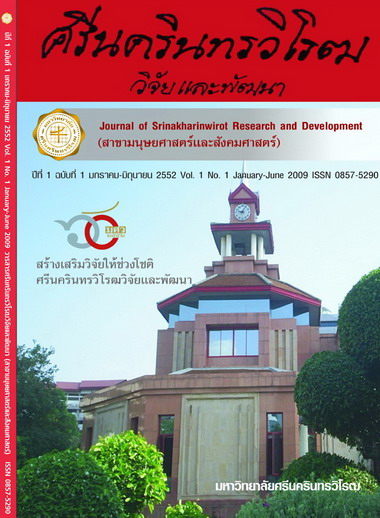หลวงพระบาง: การเปลี่ยนแปลงในฐานะเมืองมรดกโลก (Luang Prabang: Changing in the Context of World Cultural Heritage Town)
Keywords:
Luang Prabang, World Cultural Heritage TownAbstract
บทคัดย่อ"หลวงพระบาง" เป็นเมืองหลักของแขวงหลวงพระบาง สปป.ลาว ตั้งอยู่บนพื้นราบขนาดเล็ก ที่ถูกกำหนดขอบเขตและรูปทรงของเมืองด้วยลักษณะทางกายภาพของพื้นที่ทางภูมิศาสตร์ ซึ่งได้รองรับการตั้งถิ่นฐานของมนุษย์มาตั้งแต่ดึกดำบรรพ์ ในอดีตเป็นพื้นที่ทางสังคมของคนกลุ่มไทลาว กะสัก ขะมุ มีระดับชั้นทางสังคมตั้งแต่กษัตริย์จนถึงสามัญชน ตั้งแต่สมัยพระเจ้าฟ้างุ้มเป็นต้นมาหลวงพระบางได้ถูกกำหนดอัตลักษณ์ทางวัฒนธรรมด้วยบริบทของพุทธศาสนา ผสานกับความเชื่อ ผีบรรพบุรุษ และนาคาคติ ในสมัยอาณานิคม หลวงพระบางเป็นศูนย์กลางการปกครองลาวภาคเหนือ หลวงพระบางได้ดำรงอัตลักษณ์แห่งความเป็นราชธานีจนกระทั่งเปลี่ยนแปลงการปกครอง สู่ระบอบสังคมนิยมในปี พ.ศ. 2518 ในบริบทสังคมนิยม "อดีตของหลวงพระบาง" ที่สัมพันธ์กับกษัตริย์ ได้ถูกเบียดขับและกดทับไว้ไม่ให้มีเสียงปรากฏในพื้นที่ทางสังคม จึงกลายเป็น "ราชธานีแห่งความทรงจำ" ซึ่งปรากฏทั้งในการจดจำส่วนบุคคล และความทรงจำทางสังคมในรูปแบบต่าง ๆ ครั้นลาวได้เปิดประเทศด้วยนโยบายจินตนาการใหม่ หลวงพระบางถูกกำหนดให้เป็นเมืองท่องเที่ยวทางวัฒนธรรมที่สัมพันธ์กับ "อดีต" แห่งราชธานี ส่งผลต่อการเปลี่ยนแปลงจากการที่รัฐได้เปลี่ยนความหมายของราชอดีต ที่เป็นปฏิปักษ์กับสังคมนิยมว่าเป็น "มรดกของชาติ" และได้ใช้มันทำหน้าที่ใหม่ในฐานะทรัพยากรการท่องเที่ยว โดยเฉพาะการช่วงชิง สถาปัตยกรรมดั้งเดิมไปทำเป็นโรงแรมจำนวนมากเกินกว่าจะยับยั้ง ทำให้ข้ารัฐการนักอนุรักษ์กลุ่มหนึ่ง ได้สร้างให้ "ราชธานีแห่งความทรงจำ" กลายเป็นเมืองมรดกโลกในปี พ.ศ. 2538 เพื่อยุติการเปลี่ยนแปลงดังกล่าว แต่การเป็นเมืองมรดกโลกกลับจุดประกายการท่องเที่ยวอดีตให้เข้มข้นและรุนแรงยิ่งขึ้น ประการสำคัญ ยังได้ส่งผลต่อการประดิษฐ์ประเพณี ด้วยการเปลี่ยนแปลงเนื้อหา และรายละเอียดของประเพณีพิธีกรรม ในขณะที่ยังคงพยายามตรึงรูปแบบของประเพณีพิธีกรรมดังกล่าวให้ดำรงอยู่ในลักษณาการที่เสมือนอดีตก็ตาม โดยสรุป วิธีการวิจัยและผลการวิจัยเรื่องนี้เป็นประโยชน์สำคัญต่อ 1) วงวิชาการด้านไทศึกษาและวัฒนธรรมศาสตร์ ใช้เป็นแนวทางการศึกษาและทำความเข้าใจเมืองมรดกวัฒนธรรมอื่นๆ ในประเทศไทยและต่างประเทศ 2) สปป.ลาว และ UNESCO ใช้เป็นข้อมูลวางแผนดำเนินงานที่เป็นประโยชน์ผู้คนและเมืองหลวงพระบางในบริบทโลกาภิวัตน์ และ 3) ประชาชนทั่วไปได้มีมุมมองใหม่ในการทำความเข้าใจหลวงพระบางและเมืองมรดกโลกอื่นๆ ที่กำลังดำรงอยู่ในกระแสโลกาภิวัตน์เช่นเดียวกัน
Abstract
Luang Prabang, is a city located in north central Laos P.D.R. and the capital of Luang Prabang Province. It sets on a small plain where abounded by Mekong River, Kan River, and Dong River. It is a mountainous area whereas one small mountain placed in the central of the capital. Luang Prabang was a habitation area since an ancient time, and it became the first capital of Lan Xang Kingdom about 1,200 year ago. The ethnic groups were Laos, Kasak, and Kamu. The social structure was ordered from monarch to commoner. During King Fa Gnum's reign, cultural identity of Luang Prabang was popular conducted by the principles of Buddhism and old spiritual practices such as ancestor and Naga worshipping. During colonial period, French government designed Luang Prabang to be the center of colonial operations. As a consequent, Luang Prabang social structure and physical space were transformed. In 1975 Laos Kingdom transformed to be a socialist country. New government excluded and ignored Luang Prabang town for a while. Luang Prabang became just " a memorial capital town" in people and social memories. Until 1986, the Laos government in the context of "New Imaginary Policy" established Luang Prabang to be "the cultural tourism town." The concept of new Luang Prabang for a cultural heritage of the country has changed the attitude of the government to be more positive. As a result, some influence of cultural tourism rapidly changed many old style architectures to be hotel and other tourist's service places. Therefore, some conservative officials were trying to stop and conserve those old architectures. Until 1995, Luang Prabang was promoted to be the world cultural heritage, so Luang Prabang in the new context of world cultural heritage town was booming in promoting about the old town in conservation theme. Therefore, the patterns of social and ritual contents of Luang Prabang is changed and effected. In conclusion, the potential academic benefit of this research is that Thai and international academic associations can use the results and the process as a model to study in many other cultural heritage sites and Government of Lao PDR and UNESCO can use findings of this dissertation as information for policy planning on "Luang Prabang" in the process of globalization and people around the world who are interested will get new perspective to understand "Luang Prabang" and other World Cultural Heritage towns in the process of globalization.
Downloads
Downloads
Published
How to Cite
Issue
Section
License
Srinakharinwirot Research and Development Journal of Humanities and Social Sciences is licensed Under a Creative Commons Attribution-NonCommercial-NoDerivs 4.0 International (CC-BY-NC-ND 4.0) License, Unless Otherwise Stated. Please Read Journal Policies Page for More Information on Open Access, Copyright and Permissions.



